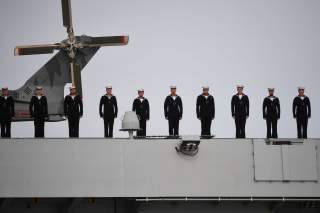The Royal Navy Is Going All In on 2 New Aircraft Carriers
The Royal Navy would become what Tony Radakin, the new first sea lord, called “a proper, carrier task group navy.”
Key point: The Royal Navy wants to become a navy centered around two aircraft carrier battlegroups.
Amid great uncertainty, the Royal Navy is about to begin its most radical reorganization in many years. With two new aircraft carriers slated to begin deploying in two years’ time, the U.K. fleet must figure out how to deploy, as a cohesive force, large numbers of warships comprising a carrier strike group.
Contrast this with the fleet’s current deployment model, which for the most part sends out single warships on solo patrols, each at their own pace.
If the reorganization succeeds, the Royal Navy will evolve from a thinly but widely spread force to one that deploys to fewer places at a time, but does so in greater concentration. The Royal Navy would become what Tony Radakin, the new first sea lord, called “a proper, carrier task group navy.”
“The whole pattern of the fleet will have to change so that a group of escort vessels and support ships are all brought to readiness together to deploy with the aircraft carriers,” the website Save the Royal Navy noted. “Changing the rhythm of deployments to this new model, while still retaining the flexibility for ships to operate independently, perhaps detaching to and from the carrier group, will be a complicated balancing act.”
The Royal Navy’s small size -- it possesses just 19 frigates and destroyers -- makes this balancing act even more complicated. A U.S. Navy carrier strike group typically deploys with one carrier, a cruiser functioning as air-defense commander plus three escorting destroyers, an attack submarines and a logistics ship. The destroyers and submarine can detach for solo patrols.
As only one-third of warship are available for operations at any given time, in the Royal Navy a single carrier strike group easily could account for more than half the deployable frigates and destroyers.
“Limited escort numbers offer limited choices but the [Royal Navy] is moving towards a new manning model which may get more from the same number of hulls,” Save the Royal Navy explained.
HMS Montrose’s permanent deployment in Bahrain with her crew rotating about every four months is effectively a trial to see if this is workable. More forward-basing could be adopted with another vessel permanently based in Singapore as an option under consideration.
Crew rotation for ships on long deployments is also a possibility. There are great efficiencies to this system as it saves long transits to and from the U.K. and extends the time a ship can be deployed in a particular region. It may also help retention as sailors are away for shorter and more predictable periods.
But forward-basing and crew-swapping are risky.
On the downside, the crew that is about to fly out to replace the current ship’s company need to train and become a coherent unit on a near-identical ship in the U.K. which imposes limits on how that vessel may be deployed.
There is also a reduced sense of ownership and pride in being part of a particular ship’s crew if frequently rotated on an off. This system has, however, already proved workable for many years on the smaller minehunters but can it be made to work for much larger and more complex vessels?
Besides providing adequate and timely escorts for the carriers, the operation of the two largest ships ever built for the [Royal Navy] presents a steep learning curve and management challenge. Considerable progress has been made on the path towards full [carrier-enabled power-projection] but there is still much to discover and re-discover about operating fixed and rotary wing aircraft in a complex joint environment at sea.
In the next three years, the manning, logistical support and availability of the carriers will have to be defined more precisely while being balanced with the needs of the navy as a whole. The employment of the carriers will have an especially weighty political and strategic dimension that may demand careful handling by [the first sea lord].
HMS Queen Elizabeth, the first of the two new carriers, is scheduled to deploy for the first time in 2021. It will be a “very high profile, operational deployment,” according to Save the Royal Navy.
David Axe serves as Defense Editor of the National Interest. He is the author of the graphic novels War Fix,War Is Boring and Machete Squad. This first appeared in August 2019.
Image: Reuters

